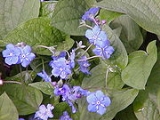
Blue-eyed Mary
Encyclopedia
Omphalodes verna is a herbaceous
perennial rhizomatous plant of the genus Omphalodes
belonging to the family Boraginaceae
.
derives from the Greek word omphalòs, meaning navel, referred to the shape of the small fruits, while the name verna of the species, deriving from the Latin vernus, refers to the early blooming flowers.
Its leaves are grooved, semi-evergreen and medium green, about30 millimetres (1.2 in) long and 20 millimetre (0.78740157480315 in) wide. They are veiny, with fine hairs and oval to heart in shape, and radipdly pointed at the tip.
In Spring the plant produces clusters of 3-5 petiolated small, light blue hermaphrodite
flowers with white or yellow star-shaped centers. The wheel-shaped corolla is fused and five-lobed and has a diameter of 7–15 mm (0.275590551181102–0.590551181102362 ). These plants bloom from March through May. The mericarp
s are hairy and navel-shaped, about 2 millimetre (0.078740157480315 in) long.
Creeping Navelwort is cultivated in many countries as an ornamental plants and it may be easily propagated from seeds. It may be confused with Forget-me-not
(Myosotis sparsiflora), from which may be distinguished by the quite different fruits.
, Pyrenees
excluded. It is also present in Quebec
.
Herbaceous
A herbaceous plant is a plant that has leaves and stems that die down at the end of the growing season to the soil level. They have no persistent woody stem above ground...
perennial rhizomatous plant of the genus Omphalodes
Omphalodes
Omphalodes is a genus of flowering plants in the family Boraginaceae.The genus is widely distributed on the Northern Hemisphere, with some species in North America, and many species in East-Asia and the Meditteranean.Some species:...
belonging to the family Boraginaceae
Boraginaceae
Boraginaceae, the Borage or Forget-me-not family, include a variety of shrubs, trees, and herbs, totaling about 2,000 species in 146 genera found worldwide.A number of familiar plants belong to this family....
.
Etymology
The genus name OmphalodesOmphalodes
Omphalodes is a genus of flowering plants in the family Boraginaceae.The genus is widely distributed on the Northern Hemisphere, with some species in North America, and many species in East-Asia and the Meditteranean.Some species:...
derives from the Greek word omphalòs, meaning navel, referred to the shape of the small fruits, while the name verna of the species, deriving from the Latin vernus, refers to the early blooming flowers.
Description
Omphalodes verna can reach 20–30 cm (7.9–11.8 ) in height. The plant has a stem that snakes across the ground (hence the alternative name of Creeping forget-me-not). It has its overwintering buds situated just below the soil surface (hemicryptophyte). This species can spread quickly, it is hard to uproot and by some accounts may even be invasive, but mostly coexists with other plants well.Its leaves are grooved, semi-evergreen and medium green, about30 millimetres (1.2 in) long and 20 millimetre (0.78740157480315 in) wide. They are veiny, with fine hairs and oval to heart in shape, and radipdly pointed at the tip.
In Spring the plant produces clusters of 3-5 petiolated small, light blue hermaphrodite
Hermaphrodite
In biology, a hermaphrodite is an organism that has reproductive organs normally associated with both male and female sexes.Many taxonomic groups of animals do not have separate sexes. In these groups, hermaphroditism is a normal condition, enabling a form of sexual reproduction in which both...
flowers with white or yellow star-shaped centers. The wheel-shaped corolla is fused and five-lobed and has a diameter of 7–15 mm (0.275590551181102–0.590551181102362 ). These plants bloom from March through May. The mericarp
Glossary of botanical terms
Many of the terms used in Wikipedia glossaries are already defined and explained within Wikipedia itself. However, lists like the following indicate where new articles need to be written and are also useful for looking up and comparing large numbers of terms together.This glossary is incomplete;...
s are hairy and navel-shaped, about 2 millimetre (0.078740157480315 in) long.
Creeping Navelwort is cultivated in many countries as an ornamental plants and it may be easily propagated from seeds. It may be confused with Forget-me-not
Forget-me-not
Myosotis is a genus of flowering plants in the family Boraginaceae that are commonly called Forget-me-nots. Its common name was calqued from the French, "ne m'oubliez pas" and first used in English in c. 1532. Similar names and variations are found in many languages.-Description:There are...
(Myosotis sparsiflora), from which may be distinguished by the quite different fruits.
Distribution
It is widespread in Central and south-eastern EuropeEurope
Europe is, by convention, one of the world's seven continents. Comprising the westernmost peninsula of Eurasia, Europe is generally 'divided' from Asia to its east by the watershed divides of the Ural and Caucasus Mountains, the Ural River, the Caspian and Black Seas, and the waterways connecting...
, Pyrenees
Pyrenees
The Pyrenees is a range of mountains in southwest Europe that forms a natural border between France and Spain...
excluded. It is also present in Quebec
Quebec
Quebec or is a province in east-central Canada. It is the only Canadian province with a predominantly French-speaking population and the only one whose sole official language is French at the provincial level....
.

